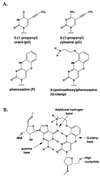A cytosine analog that confers enhanced potency to antisense oligonucleotides
- PMID: 10097067
- PMCID: PMC22324
- DOI: 10.1073/pnas.96.7.3513
A cytosine analog that confers enhanced potency to antisense oligonucleotides
Abstract
Antisense technology is based on the ability to design potent, sequence-specific inhibitors. The G-clamp heterocycle modification, a cytosine analog that clamps on to guanine by forming an additional hydrogen bond, was rationally designed to enhance oligonucleotide/RNA hybrid affinity. A single, context-dependent substitution of a G-clamp heterocycle into a 15-mer phosphorothioate oligodeoxynucleotide (S-ON) targeting the cyclin-dependent kinase inhibitor, p27(kip1), enhanced antisense activity as compared with a previously optimized C5-propynyl-modified p27(kip1) S-ON and functionally replaced 11 C5-propynyl modifications. Dose-dependent, sequence-specific antisense inhibition was observed at nanomolar concentrations of the G-clamp S-ONs. A single nucleotide mismatch between the G-clamp S-ON and the p27(kip1) mRNA reduced the potency of the antisense ON by five-fold. A 2-base-mismatch S-ON eliminated antisense activity, confirming the sequence specificity of G-clamp-modified S-ONs. The G-clamp-substituted p27(kip1) S-ON activated RNase H-mediated cleavage and demonstrated increased in vitro binding affinity for its RNA target compared with conventional 15-mer S-ONs. Furthermore, incorporation of a single G-clamp modification into a previously optimized 20-mer phosphorothioate antisense S-ON targeting c-raf increased the potency of the S-ON 25-fold. The G-clamp heterocycle is a potent, mismatch-sensitive, automated synthesizer-compatible antisense S-ON modification that will have important applications in the elucidation of gene function, the validation of gene targets, and the development of more potent antisense-based pharmaceuticals.
Figures





Similar articles
-
Characterization of a potent and specific class of antisense oligonucleotide inhibitor of human protein kinase C-alpha expression.J Biol Chem. 1999 Jan 15;274(3):1715-22. doi: 10.1074/jbc.274.3.1715. J Biol Chem. 1999. PMID: 9880552
-
Cellular penetration and antisense activity by a phenoxazine-substituted heptanucleotide.Nat Biotechnol. 1999 Jan;17(1):48-52. doi: 10.1038/5220. Nat Biotechnol. 1999. PMID: 9920268
-
Site and mechanism of antisense inhibition by C-5 propyne oligonucleotides.Biochemistry. 1995 Apr 18;34(15):5044-53. doi: 10.1021/bi00015a015. Biochemistry. 1995. PMID: 7536034
-
Rational selection of antisense oligonucleotide sequences.Eur J Pharm Sci. 2000 Sep;11(3):191-8. doi: 10.1016/s0928-0987(00)00100-7. Eur J Pharm Sci. 2000. PMID: 11042224 Review.
-
Development of antisense oligodeoxynucleotides for transplantation.Curr Opin Mol Ther. 2000 Jun;2(3):304-17. Curr Opin Mol Ther. 2000. PMID: 11249625 Review.
Cited by
-
A dynamic combinatorial approach for identifying side groups that stabilize DNA-templated supramolecular self-assemblies.Int J Mol Sci. 2015 Feb 6;16(2):3609-25. doi: 10.3390/ijms16023609. Int J Mol Sci. 2015. PMID: 25667976 Free PMC article.
-
Exploring the limits of DNA size: naphtho-homologated DNA bases and pairs.J Am Chem Soc. 2006 Jul 19;128(28):9219-30. doi: 10.1021/ja0619004. J Am Chem Soc. 2006. PMID: 16834396 Free PMC article.
-
RNase H mediated cleavage of RNA by cyclohexene nucleic acid (CeNA).Nucleic Acids Res. 2001 Dec 15;29(24):4941-7. doi: 10.1093/nar/29.24.4941. Nucleic Acids Res. 2001. PMID: 11812823 Free PMC article.
-
Fluorescent nucleobases as tools for studying DNA and RNA.Nat Chem. 2017 Nov;9(11):1043-1055. doi: 10.1038/nchem.2859. Epub 2017 Oct 16. Nat Chem. 2017. PMID: 29064490 Free PMC article. Review.
-
Characterization and use of an unprecedentedly bright and structurally non-perturbing fluorescent DNA base analogue.Nucleic Acids Res. 2008 Jan;36(1):157-67. doi: 10.1093/nar/gkm1006. Epub 2007 Nov 14. Nucleic Acids Res. 2008. PMID: 18003656 Free PMC article.
References
Publication types
MeSH terms
Substances
LinkOut - more resources
Full Text Sources
Other Literature Sources
Research Materials
Miscellaneous

